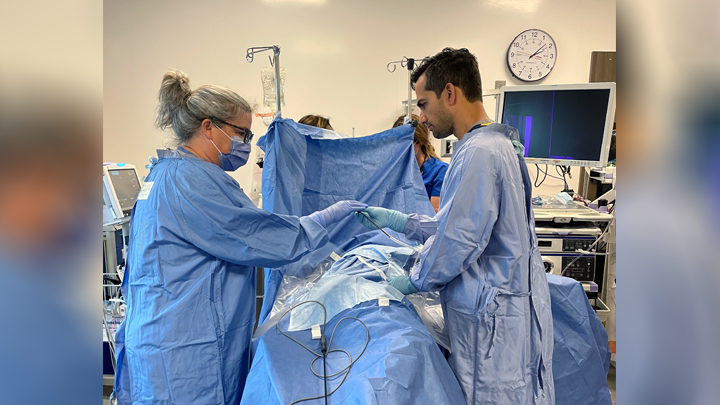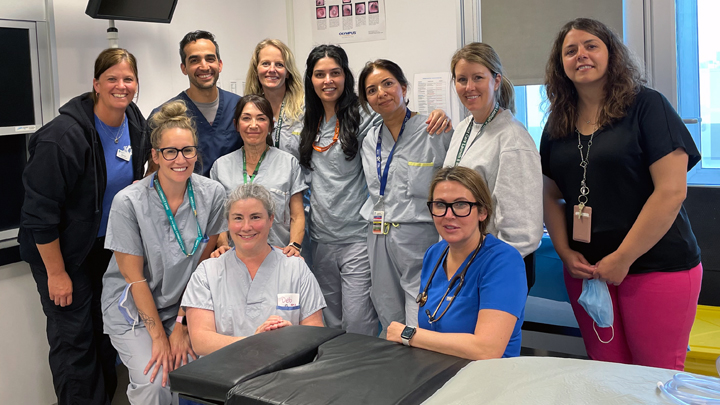
November 14, 2023

A successful pleuroscopy simulation at Foothills Medical Centre paved the way for future procedures to be performed outside of the operating room — which is reducing surgical wait times for patients waiting for their diagnosis. Pleuroscopy is a minimally invasive procedure to help diagnose and treat patients with fluid around the lung.

The bronchoscopy staff at Foothills Medical Centre in Calgary strike a pose on simulation day.
Story by Katie McLaughlin
CALGARY — Innovation, education, simulation and collaboration proved key to the success of Calgary’s first pleuroscopy procedure outside of the operating room (OR) at Foothills Medical Centre (FMC).
The centre is one of only a handful across Canada and the second in Alberta that offers the procedure for the diagnosis and management of patients with complex pleural disease.
“The pleuroscopy procedure was a major milestone in a long history of collaboration between many teams at AHS,” says Dr. Erik Vakil, Interventional Pulmonary Medicine (IPM). “Pleuroscopy continues to position our IPM program as one of the leading programs globally, offering patients the latest diagnostic and treatment options for thoracic disease.”
Pleuroscopy is a minimally invasive procedure to help diagnose and treat patients with fluid around the lung (pleural effusion). Pleuroscopy also offers the high diagnostic accuracy of video-assisted thoracoscopic surgery without the need for an OR, general anesthesia or an overnight hospital stay. It also expands the treatment options for patients with reduced surgical fitness who could not safely undergo a general anesthesia procedure.
Pleuroscopy also offers potentially new treatment options for pleural conditions where surgical intervention is not routinely offered, such as pleural infection and refractory symptomatic pleural effusions. It also provides rotating residents, visiting trainees and the IPM fellow the opportunity for comprehensive training in all aspects of minimally invasive chest procedures.
During the pilot phase of the procedure, which concluded on June 8, an interprofessional team worked together to ensure it would be delivered safely and effectively, using innovative practices to optimize the process. The generous support of the Calgary Health Foundation allowed the team to buy the specialized surgical and video equipment needed for the procedure.
“Innovation was top of mind throughout the pilot phase,” says Rana Sleiman, senior practice consultant, Perioperative Education. “For example, respiratory therapists worked to their full scope of practice so we could offer pleuroscopy outside of the OR. We also incorporated simulation to help improve the learning experience and process before completing the procedure.”
Having respiratory therapists perform circulating and scrubbing tasks enabled the team to perform the procedure outside of the OR. Rethinking how to use the workforce while optimizing the skills and training of healthcare professionals is a key component of AHS’ Health Workforce Strategy.
One of the major outcomes of the work of this team is pleuroscopy being removed from the ORs, which reduces surgical wait times for patients waiting for diagnosis of pleural disease — and frees up OR space for other surgeries. Reducing surgical wait times is one of AHS’ key priorities through the Alberta Surgical Initiative.
Simulation and education were also integral to the success of the pilot. AHS’ Perioperative Education team and FMC’s Medical Outpatient Clinics developed and delivered education, while AHS’ provincial simulation program, eSIM (Educate, Simulate, Innovate, Motivate), developed multiple simulations so the team could hone skills.
“Simulation provides healthcare providers with hands-on practice that sets them up for success,” says Mirette Dube, simulation consultant. “We worked with the team to set up simulations that tested the environmental layout and their processes. This helped build confidence and a focus on patient-centred care to ensure a safe and effective launch.”
Since the completion of the pilot, nine pleuroscopy procedures have now been successfully completed at FMC. The procedure has transitioned from the OR to the bronchoscopy suites, which has reduced pressure on the OR and improved scheduling while making the procedure more cost-effective.